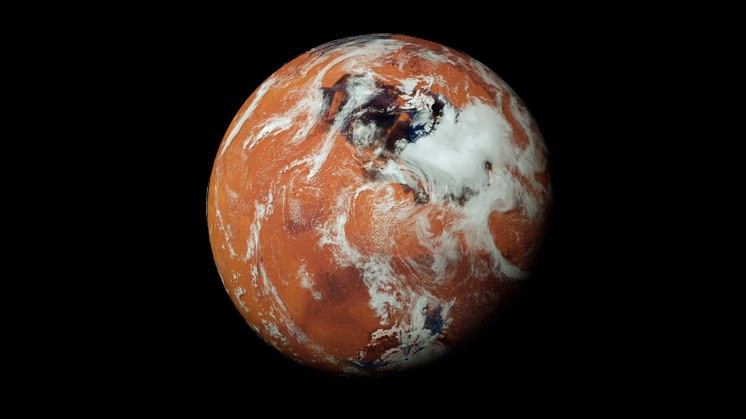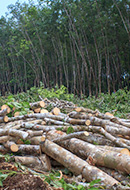Terraforming
Terraforming. Can we really live on other planets?
If human beings were forced to leave Earth due to some major event and were to decide to colonise other planets, what would we need to do to prepare? This is where the concept of terraforming comes in, which refers to potential methods for preparing other worlds to make them suitable places for living beings from Earth. Mars would seem the best choice from among our neighbouring planets, but, is it a real option or just science fiction?


The terraforming of Mars still seems like a remote possibility, which is why we need to focus on taking care of the Earth.
The atmosphere on Venus is so dense that it would crush us, never mind roasting us with a surface temperature of around 500 oC. In contrast, Mars is an icy planet that, having lost most of its atmosphere, has no oxygen for us to breathe. Our neighbours in the Solar System are therefore not particularly hospitable. However, during the last Mars mission, the Perseverence robot managed to turn carbon dioxide (CO2) from the Martian atmosphere into enough oxygen for an astronaut to breathe. This could be the first step, albeit a small one, towards the future terraforming of the Red Planet.
What is terraforming
Terraforming is the hypothetical process of deliberately manipulating the atmosphere, temperature, topography and ecology of a planet or natural satellite to transform it into an Earth-like body, able to support living beings from our planet. This concept is based on planetary engineering, in other words, the use of technology to change the conditions on a planet so that, for example, the temperature allows the presence of water in a liquid state and an atmosphere with enough oxygen for the formation of stable organic molecules.
History of terraforming
The concept of terraforming has been discussed for decades in works of science fiction, which planted the idea of adapting planets to resemble Earth. The first mentions of the term are attributed to the American writer Jack Williamson and the British author Olaf Stapledon, depending on the sources.Beyond these early mentions of terraforming, subsequent cultural contributions took the concept beyond the idea conceived of in books.
At the same time as it was being used in fiction, science applied the term to various theoretical propositions to colonise other planets. Astronomer and educator Carl Sagan, author of Cosmos, suggested using planetary engineering on Venus to make it livable in an article published in the magazine Science in 1961. His plan was to 'sow' the atmosphere of the boiling hot planet with seaweed that would sequester CO2 from the atmosphere, reducing the greenhouse effect. The term terraformation was used for the first time in 1982, when the planetary scientist Christopher McKay wrote Terraforming Mars, an article for the British Interplanetary Society which suggested a method for heating the atmosphere of Mars.
With the progress made in space exploration and the growing concern about sustainability on our planet, terraforming has become a key debate in modern science looking to the future, especially with regards to the planet Mars.

World Earth Day
This day aims to take action and protect the environment together.

Space debris
Is it time to start taking care of the cosmos?

Overexploitation of natural resources
What are the consequences of the overexploitation of natural resources?

Meteorite fallen on Earth
Meteorites on Earth: how many fall per year and why don't we see them?
Terraforming methods
Human beings need very specific conditions to live. That is why making a planet habitable would be a massive undertaking, and to be able to achieve this, several technological and biological methods have been suggested. These include:
Is it possible to live on Mars? The terraforming of the red planet
Venus' inhospitable atmosphere and the Moon's low gravity make Mars the most likely candidate for hypothetical terraforming. Nevertheless, its gravity is two-thirds that of the Earth's, the average temperature is -46 ºC and there is scarcely any oxygen in the atmosphere. It is believed that once had a denser atmosphere and liquid water, but that it lost them hundreds of millions of years ago. The reason might be that the red planet does not have a magnetic field like the Earth to protect it from the solar wind (high intensity raditation), which would certainly cause atmospheric loss.
Although Mars is the most viable candidate planet for terraforming in our solar system, technical, environmental and resource challenges make the process unfeasible with current technology. A 2018 NASA report concluded that the necessary resources do not currently exist on Mars to create a dense, warm Earth-like atmosphere: the process would involve releasing greenhouse gases to increase atmospheric pressure and surface temperature. However, according to NASA, the amount of CO2needed to do so is far greater than the resources available on the planet.
Subsequent studies have made this conclusion clear, although ongoing scientific discoveries are fuelling hopes of finding a way to survive on the red planet. A study published in 2024 by the Massachusetts Institute of Technology (MIT) suggests that the remains of an ancient atmosphere on Mars may be hidden in the clay on its surface, which would make the exploration needed to reach terraforming easier.








